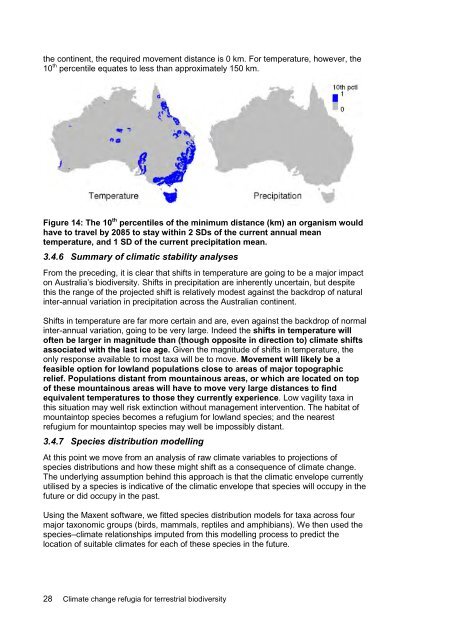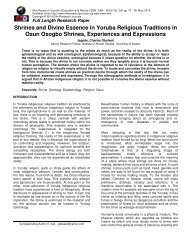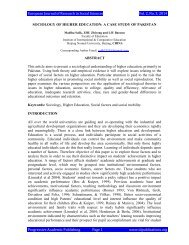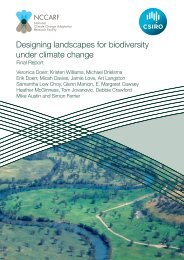Williams-Climate-change-refugia-for-terrestrial-biodiversity_0
Williams-Climate-change-refugia-for-terrestrial-biodiversity_0
Williams-Climate-change-refugia-for-terrestrial-biodiversity_0
You also want an ePaper? Increase the reach of your titles
YUMPU automatically turns print PDFs into web optimized ePapers that Google loves.
the continent, the required movement distance is 0 km. For temperature, however, the<br />
10 th percentile equates to less than approximately 150 km.<br />
Figure 14: The 10 th percentiles of the minimum distance (km) an organism would<br />
have to travel by 2085 to stay within 2 SDs of the current annual mean<br />
temperature, and 1 SD of the current precipitation mean.<br />
3.4.6 Summary of climatic stability analyses<br />
From the preceding, it is clear that shifts in temperature are going to be a major impact<br />
on Australia’s <strong>biodiversity</strong>. Shifts in precipitation are inherently uncertain, but despite<br />
this the range of the projected shift is relatively modest against the backdrop of natural<br />
inter-annual variation in precipitation across the Australian continent.<br />
Shifts in temperature are far more certain and are, even against the backdrop of normal<br />
inter-annual variation, going to be very large. Indeed the shifts in temperature will<br />
often be larger in magnitude than (though opposite in direction to) climate shifts<br />
associated with the last ice age. Given the magnitude of shifts in temperature, the<br />
only response available to most taxa will be to move. Movement will likely be a<br />
feasible option <strong>for</strong> lowland populations close to areas of major topographic<br />
relief. Populations distant from mountainous areas, or which are located on top<br />
of these mountainous areas will have to move very large distances to find<br />
equivalent temperatures to those they currently experience. Low vagility taxa in<br />
this situation may well risk extinction without management intervention. The habitat of<br />
mountaintop species becomes a refugium <strong>for</strong> lowland species; and the nearest<br />
refugium <strong>for</strong> mountaintop species may well be impossibly distant.<br />
3.4.7 Species distribution modelling<br />
At this point we move from an analysis of raw climate variables to projections of<br />
species distributions and how these might shift as a consequence of climate <strong>change</strong>.<br />
The underlying assumption behind this approach is that the climatic envelope currently<br />
utilised by a species is indicative of the climatic envelope that species will occupy in the<br />
future or did occupy in the past.<br />
Using the Maxent software, we fitted species distribution models <strong>for</strong> taxa across four<br />
major taxonomic groups (birds, mammals, reptiles and amphibians). We then used the<br />
species–climate relationships imputed from this modelling process to predict the<br />
location of suitable climates <strong>for</strong> each of these species in the future.<br />
28 <strong>Climate</strong> <strong>change</strong> <strong>refugia</strong> <strong>for</strong> <strong>terrestrial</strong> <strong>biodiversity</strong>






